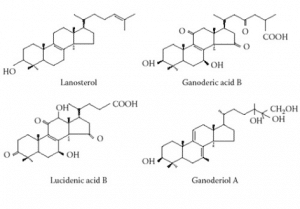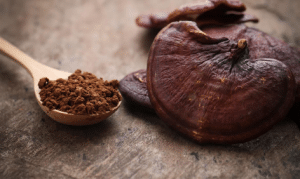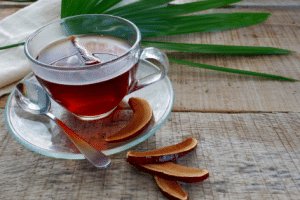Brief historical notes and studies on the Reishi mushroom
The Reishi it's a medicinal mushroom, whose botanical name is Ganoderma lucidum, and is a saprophytic fungus, that is, it feeds on decaying organic matter.
In fact the Reishi, in order to feed and live, it needs a dead and decaying woody substrate.
Keep in mind that all mushrooms are very skilled in breaking down organic matter and this is very important both for mushrooms and for us, because this characteristic is the basis of the effectiveness of mushrooms belonging to the category of medicinal mushrooms.
Category of which the Reishi is an illustrious representative, in fact al Reishi multiple and beneficial actions are ascribed to our health and our organism. Like all the other mushrooms covered in these articles.
Reishi is its Japanese name, but in China it is known as Lingh Zhi. And speaking of China, the Reishi is counted in the oldest Chinese herbarium, long before the year zero, and in all this time more than one legend about the Reishi.
But beyond the halo of legends and mysticism that surrounds this mushroom, the important thing is that science is clear: the Reishi it truly offers a series of physiological benefits to our body.
And in this regard, I cite some studies that I found very useful for the purpose of writing this article:
“Ganoderma lucidum (Reishi mushroom) for cancer treatment“
“Ganoderma lucidum (Reishi mushroom) and cancer“
“Cellular and physiological effects of Ganoderma lucidum (Reishi)“
“Ganoderma lucidum (Reishi) mycelia enhance innate immunity by activating NF-KappaB“
“Cellular and molecular mechanism of immunomodulation by Ganoderma lucidum (Reishi)“
What is Reishi?
The Reishi it's a medicinal mushroom, Asian folk medicine considers it capable of exercising beneficial actions towards our health and official medicine, through various studies, has confirmed what folk medicine has been claiming for a very long time.
As already mentioned, the Reishi is a saprophytic mushroom whose botanical name is Ganoderma lucidum. The term saprophyte means that this fungus feeds on decaying organic matter.
In the great skill that i medicinal mushrooms possess in breaking down organic matter, lies part of their effectiveness in exercising various benefits towards us.
What is Reishi used for?
The physiological benefits that arise from taking the Reishi are many:
- Promotes the reduction of blood sugar levels, since the Reishi is able to inhibit the process of neoglucogenesis.
And at the same time the Reishi stimulates the synthesis of glycogen; - it promotes the reduction of cholesterol levels, more precisely it acts on cholesterol LDL, that is the one commonly defined "bad cholesterol", responsible for the dangerous atherosclerotic plaques, which are formed by the so-called small fraction of bad cholesterol, which oxidizes and settles, thus forming plaques;
- the Reishi offers support to our immune system by enhancing the action of cells such as i lymphocytes, of the macrophages and gods natural killer;
- exerts an antioxidant action, counteracting the action of free radicals, which are chemically very unstable and particularly aggressive molecules.
It does this through a mechanism of boosting antioxidant enzymes, which are ultimately a type of protein; - the Reishi exerts an important antitumor action, thanks to some bioactive principles contained in it.
These bioactive principles, therefore these molecules, induce apoptosis, i.e. programmed cell death, against cancer cells. Furthermore l'intake of Reishi it is supportive during chemotherapy treatments, in the sense that it improves the response that this treatment induces in patients; - the Reishi it is an effective anti-inflammatory and, in this regard, we will have time to deepen the subject;
- the Reishi offers hepatoprotective action, that is, to protect the liver.
What does Reishi contain?
The Reishi it contains important bioactive principles, and it is thanks to them that it exerts various physiological benefits towards us. In Reishi we find:
- Triterpenes, which are a subclass of the Terpenes. TOBy abandoning the narrow technical terminologies, they can be defined as a particular type of plant compounds, which are characterized by a basic carbonaceous skeleton having as many as 30 carbon atoms.
But triterpenes is a somewhat generic term, and one can be more specific.
In particular in the Reishi is theganoderic acid, which has a steroid-like chemical structure and is a Triterpene found in mushrooms of the genus Ganoderma.
There is no need to mention that the botanical name of the Reishi is exactly Ganoderma lucidum.
Fig. 1 - Various types of Triterpenes
- Polysaccharides, in particular beta glucans. By polysaccharides we mean polymers formed by the union of over 10 monosaccharides, ie sugars.
Beta glucans, that is this chain of particular sugars, now enjoy the fame they deserve, in fact they are considered effective natural drugs.
Anyone wishing to learn more quickly and easily can read the introduction to mycology.
- Mannitol, it's a alditol chiral, a molecule belonging to hexahedral sugar alcohols, but in practice it is a simple carbohydrate.
And it can be found under different names, but the molecule is always the same.
Mannitol is also called D-Mannitol, sometimes Mannite, or with the initials E421.
- Proteins, which are large organic molecules made up of hundreds or thousands of amino acids, which in turn are the basic unit of proteins.
- Coumarins, which are a family of plant substances having various and beneficial actions on the organism.
Reishi as an anti-inflammatory?
Yes the Reishi exerts an anti-inflammatory action, as it exerts an action similar to that performed by hydrocortisone drugs, but the Reishi it is quite natural.
In Reishi there is a lot Germanium, which induces the production of endorphins, which in turn reduce inflammatory states.
Who has already tried Reishi?
Who has already tried Reishi it has certainly increased its antioxidant abilities.
Since theregular intake of Reishi, increases the amount of glutathione in the blood with a consequent increase in the activity of antioxidant enzymes.
But not only. Who has already tried Reishi he will also have "defatted" his liver.
Because the improvement of the condition of the fatty liver is one of the aspects of the hepatoprotective capacity of the Reishi.
It is not me who is saying all that I have described to you, but of course it is science.
Since these few lines are the summary of a very interesting study, as always, I do not fail to mention its source:
It should be noted that the study in question was conducted with the method of randomized double blind, so as not to create any flaws in the results.
Reishi powder?
The Reishi powder, that is, a good product intended as a supplement, brings all the benefits that can be enjoyed through a diet rich in Reishi mushroom.
In Reishi powder, all those bioactive principles so useful for our health and our organism are contained.
In the studies that I love to mention, and from which important scientific evidence emerges, it is used precisely Reishi powder.
In all studies the Reishi powder it is always weighed, so we must do it too since there are very precise dosages to be respected.
Fig. 2 - The powder of Reishi contains all the virtues of the mushroom Reishi
How to use Reishi (mushroom)?
If we want we could prepare one herbal tea based on Reishi mushroom, exactly like the Japanese do.
To do this you need to have a dried Reishi mushroom, from which 2 to 3 sheets are taken.
In the meantime we will have put some water to boil and in that water, once it has boiled, put the foils for about twenty minutes.
It's not ready to drink yet, or at least I don't recommend it. It should be filtered and left to rest for a while, just long enough for it to cool.
Well now it's ready to drink. What I have just described to you is the traditional oriental method.
It should be drunk like this, but not everyone can like the taste, you can still add a natural sweetener.
Note that the Reishi it is a “woody” mushroom, it is not a soft mushroom, so even if you want to use it for a soup, another traditional oriental method, it must always be boiled first.
How is Reishi (mushroom) taken?
It depends, in the sense that it depends on whether we intend to eat it after preparing it, cooking it and putting it in a soup… so after boiling it. Or if we are going to use it to prepare one herbal tea / infusion of Reishi.
But one thing is certain, we must not think, after just one intake, of enjoying the benefits described throughout the article.
The bioactive principles contained in the Reishi must be cycled.
This means that in whatever form we decide to take it (soup, herbal tea, supplement), we must take it daily.
Very small amounts are enough, but they must be taken every day. Only in this way will we enjoy the benefits that the Reishi can give us.
If we decide to use a good supplement containing the bioactive principles of Reishi, it would be advisable to take it in the morning, or in any case on an empty stomach.
Also, it should be kept in mind that taking a Reishi supplement produces the best benefits when taken in conjunction with aabundant water and vitamin C.
When are Reishis used?
After all that has been said about the property of the Reishi, to question qWhen are Reishis taken? it could be answered in various ways.
And that is when you suffer for example from high blood sugar or high cholesterol, or when you want to support the immune system. Well, nothing more correct, but also nothing more wrong.
In the sense that you don't have to wait until you are suffering from a pathology to make use of Reishi.
So when are reishis used? When we intend to lend a hand to our health and our body. And without being forced to wait for the onset of a disorder.
In order for them to exercise their beneficial actions, i Reishi they must be cycled and to do so you have to take them every day.
Where are Reishis bought?
Where do you buy Reishi mushrooms?…It depends.
In the sense that it depends on whether we intend to buy the real mushroom, or a good supplement.
With the real mushroom we can prepare a soup, or an infusion and, in this case, we will have to contact an organic food store, or a supermarket that has Reishi mushrooms.
If, on the other hand, we wanted to enjoy the benefits that can arise fromtaking the Reishi, without having to cook, then thesupplement is what it does for us.
And in this case where do you get Reishis? From a serious and reliable manufacturer.
Reliability and seriousness is also certified, if a manufacturer has the GMP then it is serious and reliable with a lot of certification.
But be careful, to actually own the GMP must have the patent number, i.e. the certification code issued by the certifying body.
Without that code he simply wrote 3 letters on the packaging, or on his website, and this is the first thing that must make us understand that he does not really own the GMP.
Purchase a Reishi supplement, from those who exhibit the GMP with a lot of certification number is a guarantee.





Sono un conoscitore ed appassionato di funghi. Conosco questo fungo e lo trovo spesso. Non l’ho mai raccolto, mi date qualche consiglio per la sua raccolta e poi usarlo? Chiedo ad esperti e conoscitori specifici di questo fungo -Ganoderma Lucidum- cosiddetto Reishi.
Grazie.
Raffaele Vicedomini
Gentile Raffaele, grazie per averci scritto. Ci auguriamo che altri utenti possano condividere qui la loro esperienza. Un coriale saluto